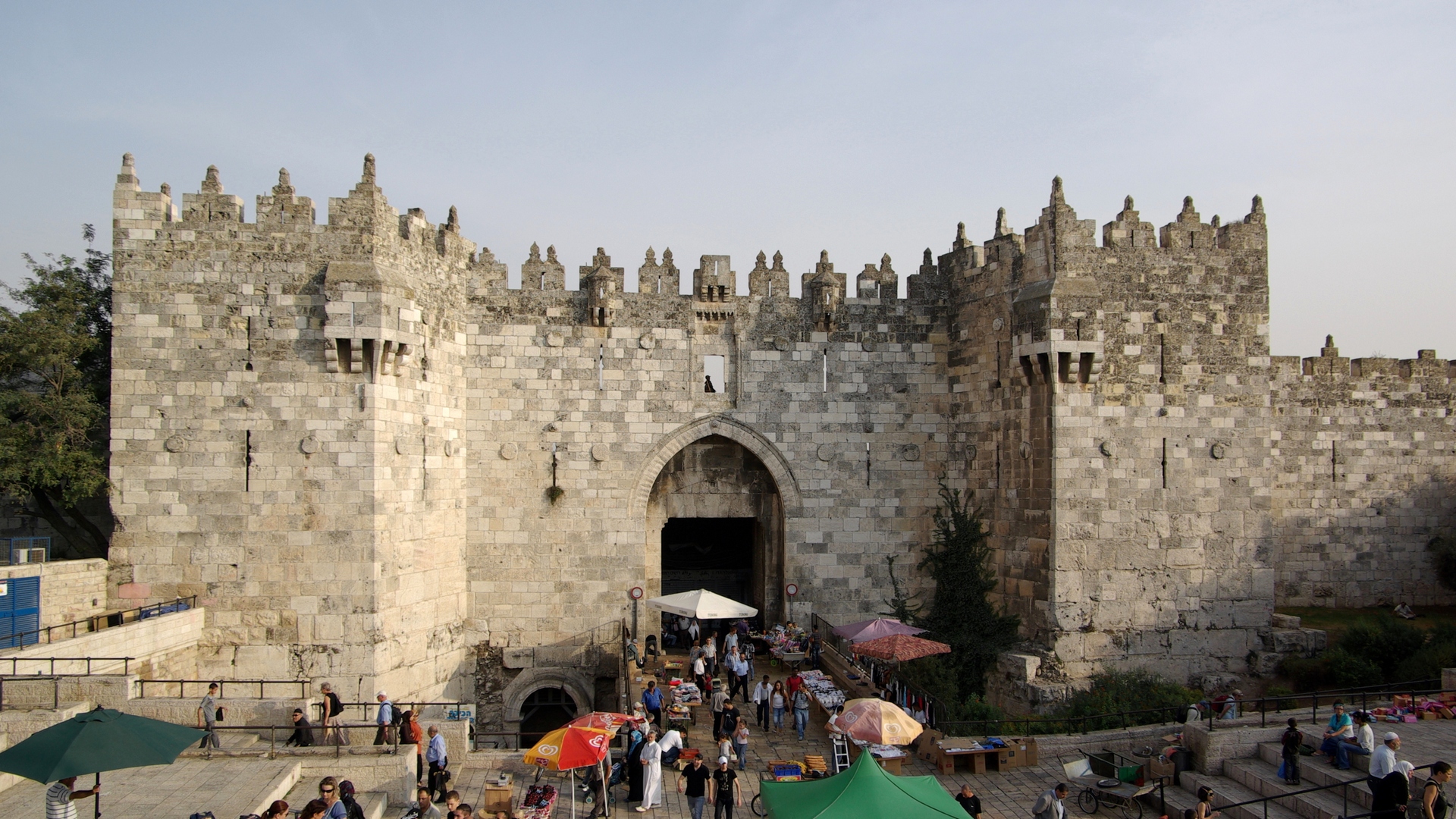Description
Property Name: Damascus Gate, Bāb al-ʿĀmūd
Inventory No: 972-2-18
Date of infill of the inventory form: 2020-07-23
Country (State party): Palestine
Province: Al Quds/Jerusalem
Town: Old town
Geographic coordinates: 31°46’53.83″N
35°13’49.47″E
Historic Period: Ottoman
Year of Construction: 1537-39 AC
Style:
Original Use: Gate
Current Use: Gate
Architect: Unknown
Significance
As in all cities of the East, the gates of Jerusalem were named either according to their direction or by the city they faced. The Damascus Gate is as multi-named as the city of Jerusalem. Another name is Nablus Gate. The Arabic name of the gate has an interesting historical depth. Roman Emperor Hadrian had the city rebuilt in the second century C.E. and erected a column inside this gate. All the roads and buildings of the city were constructed using this column as a reference point and later a statue of Hadrian was also erected on the column. In time both the statue and the column were lost, but stayed alive in the gate’s name: Today Arabs call the Damascus Gate Bab al-‘Amud (The Gate of the Column).
The Damascus Gate was Jerusalem’s main portal until the 19th century, when it lost this position to al-Khalil Gate. Markets were installed around it, caravans would unload their pack animals there and main custom formalities were carried out outside the gate. Nobody knew at the time, but archaeological excavation in the 20th century revealed that the Ottomans had built this gate on the site of a Roman portal. The Damascus Gate, built in the Valley that defined the topography of Jerusalem, stands well above the base of the valley, which was filled in with earth and aggregate. The level of the earth collected around the gate was probably not at its 19th-century level when the gate was first built, together with the city walls, in 1537-38. The removal of the accumulated earth and uncovering of the gate in all its majesty was possible only in the last quarter of the 19th century.
Selection Criteria
ii. to exhibit an important interchange of human values, over a span of time or within a cultural area of the world, on developments in architecture or technology, monumental arts, town-planning or landscape design
iii. to bear a unique or at least exceptional testimony to a cultural tradition or to a civilization which is living or which has disappeared
vi. to be directly or tangibly associated with events or living traditions, with ideas, or with beliefs, with artistic and literary works of outstanding universal significance
State of Preservation
The gate was restored in August 2011.
References
ed. Auld, Sylvia and Hillenbrand, Robert; arch. survey by Yusuf Natsheh. Ottoman Jerusalem: the living city: 1517-1917. London: Altajir World of Islam Trust, 2000.
Al-Quds, A Historical Document. Organization of the Islamic Conference.
Bahat, Dan. A selection of Ottoman Structures in the old city of Jerusalem. Jerusalem: The Open University of Israel, 1990.
Bahat, Dan. Carta’s Historical Atlas of Jerusalem, 1983
Burgoyne, Michael Hamilton. Mamluk Jerusalem, an architectural study. Scorpion Publishing Ltd., Essex, England 1987
Creswell, K.A.C. A Short Account of Early Muslim Architecture. Penguin Books, Harmondswoth, 1958.
Duncan, Alistair, The Noble sanctuary: portrait of a holy place in Arab Jerusalem. London: Longman, 1972.
Elad, Amikam. Medieval Jerusalem and Islamic Holy Places, Ceremonies, Pilgrimage. |Brill Leiden, Netherlands, 1995.
Grabar, Oleg. Jerusalem, Constructing the Study of Islamic Art, Volume IV. Ashgate Publishing Company, Hampshire, 2005.
Grabar, Oleg. The Dome of the Rock. Thames and Hudson Ltd., London, 1996.
Ed. Hattstein, Markus, Delius. Peter. Islam Art and Architecture. Könemann Verlagsgesellshaft mbH, France, 2000.
Jerusalem Institute for Israel Studies, Statistical Yearbook of Jerusalem, 2002/03
Kroyanker, David. Jerusalem Architecture. Tauris Parke Books, London, 1994.
Najm, Raip Yusuf, The Treasures of Jerusalem. Arabic Cities Organization, Al-Beti Establishment, 1983.
Sha’th, Shawqi. Al-Quds Al-Shareef. ISESCO, Rabat,1995.
Wilson, Colonel Sir Charles W. Jerusalem, The Holy City. Ariel Publishing House, Jerusalem.
Flood, F.B. 1997. Umayyad Survivals and Mamluk Revivals: Qalawunid Architecture and the Great Mosque of Damascus. Muqarnas XIV: An Annual on the Visual Culture of the Islamic World. Gülru Necipoglu (ed). Leiden: E.J. Brill, 57-79.
Grabar, Oleg. The Haram al-Sharid: An Essay in Interpretation, BRIIFS vol.2 no.2 Autumn 2000.
Jarrar, Sabri. 1998. Suq al-Ma’rifa: An Ayyubid Hanbalite Shrine in al-Haram al-Sharif. Muqarnas XV: An Annual on the Visual Culture of the Islamic World. Gülru Necipoglu (ed.) Leiden: E.J. Brill, 71-100.
Khalidi, Walid. The Dome of the Rock. Retrieved from Saudi Aramco World website: http://www.saudiaramcoworld.com/issue/199605/the.dome.of.the.rock.htm
Khoury, Nuha N.N. 1993. The Dome of the Rock, the Ka’ba, and Ghumdan: Arab Myths and Umayyad Monuments. Muqarnas X: An Annual on Islamic Art and Architecture. Margaret B. Sevcenko (ed.). Leiden: E.J. Brill.
Laurent, B. and Riedlmayer, A. Restorations of Jerusalem and The Dome of The Rock and Their Political Significance, 1537-1928
Leisten, Thomas. 1996. Mashhad Al-Nasr: Monuments of War and Victory in Medieval Islamic Art. Muqarnas Volume XIII: An Annual on the Visual Culture of the Islamic World. Gülru Necipoglu (ed.). Leiden: E.J. Brill.
Rabbat, Nasser. 1989. The Meaning of the Umayyad Dome of the Rock. Muqarnas VI: An Annual on Islamic Art and Architecture. Oleg Grabar (ed.). Leiden: E.J. Brill.
Rabbat, Nasser. 1993. The Dome of the Rock Revisited: Some Remarks on al-Wasiti’s Accounts. Muqarnas X: An Annual on Islamic Art and Architecture. Margaret B. Sevcenko (ed.). Leiden: E.J. Brill.
Richard Ettinghausen, Oleg Grabar, Marilyn Jenkins-Madina (1987),The Art and Architecture of Islam 650-1250 c.e. (pp.28-34)
Yavuz, Yildirim. 1996. The Restoration Project of the Masjid al-Aqsa by Mimar Kemalettin (1922-26). Muqarnas Volume XIII: An Annual on the Visual Culture of the Islamic World. Gülru Necipoglu (ed.). Leiden: E.J. Brill.
UNESCO, (1995) General Conference Twenty-eighth Session Report
Archnet website: archnet.org
Organization of the Islamic Conference Research Centre for Islamic History, Art and Culture
AL-QUDS/JERUSALEM IN HISTORICAL PHOTOGRAPHS: İSTANBUL, 2 0 0 9.


